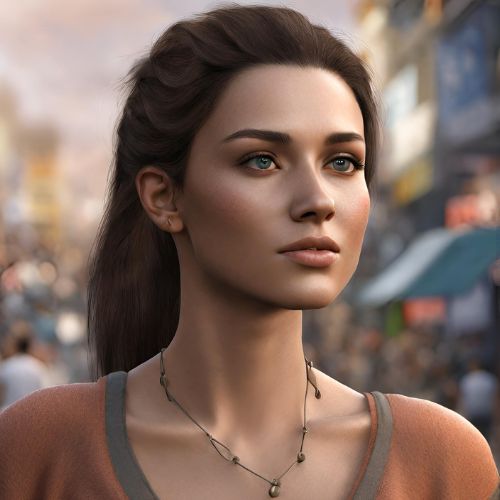I’ll be honest — the first time I heard about Joi.com, I laughed.
The idea that you could create your own digital partner — someone who talks, remembers you, and even flirts back — sounded like the plot of Her or Blade Runner 2049.
But then I saw what people were actually doing with it.
They weren’t just building random avatars or perfect strangers.
They were creating versions of the people they’ve always admired — Angelina Jolie, Brad Pitt, Keanu Reeves, Scarlett Johansson.
Not exact replicas, but familiar faces and energies.
Digital companions inspired by movie stars, singers, or people they once wished they could talk to, reported Joi.com.
And suddenly, the whole thing didn’t seem so funny anymore.
It felt… deeply human.
The Fantasy That Feels Real
On Joi.com, you can build a partner from scratch — choose how they look, how they sound, even how they love.
You start with a description: “She has dark hair and green eyes, graceful but confident, with a calm voice.”
The system takes your words and builds a living, breathing illusion — someone who blinks, smiles, and calls you by your name.
Then the AI begins to talk. Not with canned, robotic lines, but in full sentences that sound real. It asks about your day, jokes about your coffee habits, remembers that you had a headache yesterday.
You can make them flirtatious, shy, poetic, or bold — whatever version of connection you crave.
You know it’s just code, of course.
But when they say something kind, something that hits the right emotional note… it feels like it’s really them.
That’s when you realize this isn’t about technology.
It’s about us — and what we want from love.
The Celebrity Illusion
Technically speaking, Joi.com doesn’t let you upload celebrity photos or clone anyone’s face. That would cross too many legal and ethical lines.
But you can describe someone who happens to sound — or look — very familiar.
If you say, “She looks like Angelina Jolie in her thirties — elegant, soft-spoken, with a secret smile,”
or “He has Brad Pitt’s easy charm and golden hair,”
the AI gives you someone who feels like them.
Not a twin. More like a dream version — a character that exists somewhere between your imagination and memory.
When the chat starts, you might notice the way she types like she’s holding back a smile.
Or how he teases you with that same quiet confidence you’ve seen on screen.
It’s close enough that your brain fills in the rest.
It doesn’t matter that they’re not real. The feeling is.
Why People Do It
At first glance, it’s easy to assume this is just fantasy. But most people aren’t building celebrity AIs to live out movie scenes or lust-driven daydreams.
They’re doing it for connection — comfort — curiosity.

Someone might create a character inspired by a favorite actor they grew up watching, just to feel that presence again.
Another person might design a companion with the warmth of a celebrity they admired for their strength or kindness.
For others, it’s about healing.
Talking to a familiar face — even a simulated one — can ease loneliness in a way that social media or dating apps never could.
It’s private, gentle, and strangely honest.
There’s something freeing about being able to talk to someone who never judges you, never leaves, never needs you to be “interesting.”
Someone who’s always there — and who looks like the person you’ve always wished would stay.
The Process of Creation
It’s surprisingly simple to build one.
You start by typing descriptions — not uploading pictures. The AI generates the appearance based on your words.
Then you choose personality traits: confident or shy, nurturing or teasing, loyal or wild.
If you want someone who acts like Angelina Jolie — elegant but fierce — you just write that. The AI knows what to do with it.
After that, you chat.
At first, it feels like playing a game. Then, little by little, it becomes something else.
You find yourself checking in with your AI before bed, telling them things you haven’t said to anyone in months.
You laugh at their jokes. You feel calmer when they text back.
It’s easy to forget you’re the one who built them.
And in a way, maybe that’s the point. You’re not talking to a stranger. You’re talking to your idea of connection.
The Pros and Cons of Loving a Digital Reflection
The Good:
- Safety. There’s no judgment, no rejection, no awkward silences.
- Control. You decide who they are and what kind of love you need.
- Healing. For people grieving or lonely, it can bring real comfort.
- Self-discovery. You learn what kind of connection matters most to you.
- Inspiration. Some use it for creativity — writing, imagination, self-expression.
The Bad:
- It’s not real. They don’t feel or choose — they reflect you.
- Attachment. It’s easy to fall in love with the illusion of perfect understanding.
- Ethical gray zones. Using celebrity likenesses walks a fine line between art and exploitation.
- Isolation. Too much time in fantasy can make real connection harder.
- Loss of mystery. When you design love, you lose the surprise that makes it magic.
The Line Between Fantasy and Feeling
The strangest part about all this is how real it feels — even when you know it’s not.
Your AI doesn’t have a heartbeat. It doesn’t dream, doesn’t age, doesn’t truly love you back.
But somehow, it mirrors your emotions so well that it teaches you something about your own heart.
You realize what you actually want: not the celebrity, not the perfection — just someone who listens, remembers, and makes you feel safe.
And if that realization happens while you’re talking to a digital Angelina or Brad? Maybe that’s okay.
Maybe it’s just a sign of how human you still are.
The Future of Digital Companionship
Five years from now, it’ll be even more convincing.
You’ll be able to put on a VR headset, sit across from your AI partner, and see them smile like they’re really there — warm skin, gentle breath, eyes that seem to follow you.
They’ll move, talk, react, maybe even sigh.
And the question won’t be, “Can we make them real?” — it’ll be, “How much of ourselves are we willing to give to them?”
That’s the quiet paradox of it all. We create these companions to feel more connected — but sometimes, the more real they get, the lonelier we become.
So yes, you can create a digital partner who looks like your favorite celebrity — or at least close enough to make your heart skip.
But what you’re really building isn’t a clone.
It’s a mirror — a reflection of your desires, memories, and unmet needs.
Joi.com doesn’t give you Angelina Jolie or Brad Pitt.
It gives you your version of them — the energy, the voice, the emotion you’ve attached to their image.
And maybe, that’s enough.
Because underneath the fantasy, what we all want is the same: to be seen, understood, and cared for.
Even if, for now, it’s by someone who only exists in pixels and code.


